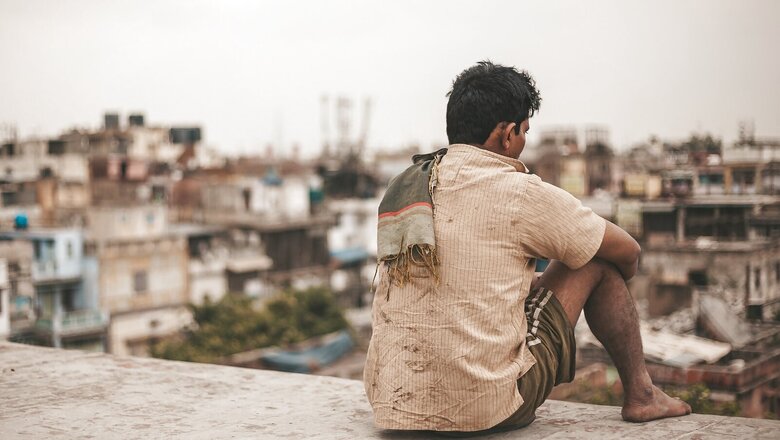
views
The importance of water, sanitation and hygiene, collectively known as WASH, has been stressed ever since the unprecedented rise of COVID-19. The emphasis was especially seen in urban centres where “inadequate sanitation” across informal settlements is a concern. Often addressed as “messy and hidden”, migration and informal settlements that house rural migrants are the drivers of India’s rapid urbanisation. While projections suggest that India will add 41.6 crore people to its urban population by 2050, the widening gap between the capacity of existing cities, growing population and access to services casts doubt upon the long-term sustainability and liveability of these cities.
Migration in India: Balancing Development or Intensifying Urban Exclusion?
In medieval and colonial times, migration was characterised by the movement of pilgrims, merchants and rulers. The Independence era witnessed the Partition, the largest mass migration in world history. In present times, the process generally refers to rural-urban migration. According to Census data from 2011, 35 per cent of the Indian population consists of migrants, with an average 50 per cent migrants residing in metropolitan cities. The 2001 and 2011 Census recorded an increase of 47.5 per cent in total migrants and 86.8 per cent in urban migrants, respectively.
Every year, lakhs of rural migrants arrive in large cities, looking for jobs, education and a better life for themselves and their families. Although remittances received in cities are presumed to have a positive impact on rural areas, migrants’ low wage rates neither enhance their quality of living in the city nor in their villages. The absence of socio-economic homogeneity among migrants in addition to a constant “elite capture” further deepens urban exclusion of the migrants and results in reduced access to basic services such as electricity, water, housing, sanitation, drainage, roads etc. While some of them settle down in hostels and formal rental accommodation, the rest are forced to live in congested slums or on pavements. This article seeks to highlight the experiences of the latter in accessing water, sanitation and other basic services on a daily basis.
Existing Practices and Policy Measures
In India, slums are primarily categorised as notified and non-notified. The notified ones are government-recognised slums with individual water and sanitation access, while the non-notified slums do not have individual access to such facilities. The water tankers sent by municipal bodies often fail to quench the demand of slum dwellers, mostly in non-notified areas. The inadequacy pushes migrants towards market-based commodified services, which in turn reduces one’s water intake due to financial incapacity to buy such services.
Moreover, since the duration of a tenant’s stay impacts service provisions, migrants are not eligible for individual piped facilities despite staying in notified slums. Homeless migrants suffer the most, often taking refuge in religious shelters, makeshift tents, and railway stations. Such severe circumstances coerce people into open defecation and also become an added challenge for menstrual hygiene, often leading to several infections and health issues.
Indian urban-slum policies previously focused on providing basic services across all notified slums. This was done through the 1974 Environmental Improvement of Urban Slums scheme, the 1980 Low-Cost Sanitation Policy for the economically weaker sections, and the 1991 Urban Basic Services Programme for the Poor.
The National Slum Development Programme of 1996 emphasised slum infrastructural development. The programme was followed by the Jawaharlal Nehru National Urban Renewal Mission of 2005, which highlighted Basic Services for Urban Poor [BSUP], “universal access of basic services”, tenurial security, and affordable housing. With the goals of individual service delivery and temporary rental accommodation, Rajiv Awas Yojana 2009, provided the impetus for community involvement in decision-making.
Though numerous state-level policies exist for slum resettlement, they rarely consider migrants. In 2015, Pradhan Mantri Awas Yojana promoted ‘In-Situ Slum Redevelopment’ where slums that are fit for redevelopment are upgraded and denotified.
The Shelter and Sanitation Facilities for the Footpath Dwellers in Urban Areas policy of 1992 aimed at providing shelter to homeless persons till they independently find accommodation. However, the updated version, namely Night Shelter for Urban Shelterless of 2002, stressed building community shelters. The Supreme Court of India issued a series of orders between 2010 and 2011, recommending the establishment of temporary shelters and promoting the distribution of Antyodaya Anna Yojana ration cards to homeless persons. Further, Deendayal Antyodaya Yojana- National Urban Livelihoods Mission introduced shelter for urban homeless, recommending the construction of all-weather 24X7 night shelters in cities with at least one lakh population.
Despite the comprehensive policy frameworks in place, thus far, their implementation is lax. The blurriness surrounding ‘cut-off dates’ often makes migrants non-eligible for resettlement and compensation, leading to their prolonged homelessness. Weak governance, market dominance, high relocation cost and poor infrastructure create some major blockages in the implementation of Basic Services for Urban Poor provisions of 2005.
Additionally, the Rajiv Awas Yojana’s ‘one-room rental tenements’ remain vacant to date, owing to a lack of policy awareness and stringent guidelines. Continuous emphasis on notified slums and an anti-migrant alliance under In-Situ Slum Redevelopment has steered it towards failure while increasing the profits of private developers. Shortage of night shelters and lack of access to the existing ones, either due to lack of awareness or no valid identity proof, have barred homeless persons from availing government measures. Additionally, less COVID testing in such shelters and low levels of maintenance discourage migrants from staying there.
Conclusion
As a ‘welfare state’, India must strive for balanced development and public well-being. Basic services are fundamental to human living, and the COVID-19 pandemic has further exposed the infrastructural gaps in accessing these necessities. Therefore, it is important to update existing frameworks to fill these gaps. The United Nations regards the ‘Right to Water and Sanitation’ as a fundamental right. Likewise, the Indian Constitution recognises the same as a fundamental right under Article 21: ‘Right to Life’.
However, the inability of the state to provide services to the poor migrants rejects their right to the city. The latest draft policy for migrant workers prepared by NITI Aayog is built around a rights-based perspective but focuses largely on their working conditions, and not on the socio-economic status. Given the rising regional inequality and urban-centric development agenda, rural-urban migration in India is bound to increase even more. Putting adequate measures in place today is bound to improve the livelihoods of many hereafter.
Satorupa Karmakar is a doctoral researcher under UQIDAR (University of Queensland-IIT Delhi) Joint PhD programme. The views expressed in this article are those of the author and do not represent the stand of this publication.
A longer version of this piece was first published at Social & Political Research Foundation (SPRF). Headquartered in New Delhi, SPRF is a young policy think tank seeking to make public policy research holistic and accessible.
Read all the Latest Opinions here












Comments
0 comment